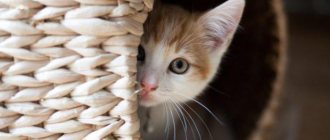Cat lovers know well how afraid their pets are of water. That's why they obsessively groom their fur almost every minute, and we don't even begin to plan how to get them into the bath.
Actually, not quite like that. Yes, most cats prefer land over water, but there are quite a few breeds that enjoy water in many forms.
Of course, the degree of love for water varies from cat to cat, but those pets who really love to get their paws wet will be happy to join you in the bath and even in the shower! Want to know if your cat is attracted to water? Then read on!
Turkish van
These cats live in the vicinity of Lake Van in Turkey and hunt fish, amphibians, water rats and birds. The Turkish Van has no undercoat, and the guard hairs are covered with a fatty film that repels water. The home van loves to play with a trickle of water from the tap, splash in the basin, and if you pour warm (+38°C) water into the bath that corresponds to the animal’s body temperature, then he will willingly swim in the home pond.
Maine Coon
www.youtube.com
Who is the largest breed in the world? Who looks down on sissy domestic cats with poor health and fear of water? Of course, we are talking about the Maine Coon, an amazing breed of huge aboriginal cats, the embodiment of grace, strength and beauty.
The ancestors of the Maines were favorites of seafarers and often traveled on sailing ships. Maybe this is why cats are so calm about water? They also drink very funny - they often scoop up water with their paws like a spoon and lick it off their paws. It is believed that this is how they get rid of dirt found on the surface of natural bodies of water.
Turkish Angora
Another representative of the cat tribe from Turkey. The owner of long and fluffy fur is not fond of water procedures, but at the same time she is an excellent swimmer and is not averse to playing with flowing, splashing, dripping water. Some Turkish Angoras love to take a shower with their owner, but not because of a craving for water, but to be constantly close to the adored ruler of the cat's heart.
Bengal cat
Bengal cats look like wild cats, and for good reason, their closest relatives are the wild Asian leopard cats. However, this breed is completely domesticated.
Bengals have amazingly dexterous paws that can magically catch literally anything in the water! They are not afraid of water, and if they hear the sound of rain or a shower, then be prepared for an unexpected meeting with your pet!
Manx
According to legend, the cat's long tail was cut off by the closing door of the ark when at the last moment it darted towards Noah's "menagerie". The murmuring stream of water simply puts the Manx into a trance. She herself knows how to cause a “waterfall” by pressing the toilet or faucet flush handle.
The list goes on. Water lovers are found among many breeds and mongrel cats.
American Bobtail
www.metaphoricalplatypus.com
This is a young breed, officially recognized about 50 years ago. They are often called “cat-dogs” for their affection for the family, their ability to learn, and their love of water and walking on a leash.
American Bobtails are good at sensing their owner’s mood, which is why they are used in therapy and in the treatment of depression. They get along equally well with all family members, guests and pets. True, they themselves need constant attention, otherwise they may start to feel sad.
Video
Cat lovers know very well how much their pets dislike water. But not all of them run away from swimming in panic; there are cat breeds that adore water and swimming.
Each cat's love of water varies differently, but those pets who are not afraid to get their paws wet can enjoy swimming in the bathtub or in open water.
Maine Coon.
A large, bright, loving, handsome dog with a unique water-repellent coat. A warm and devoted heart lurks in the chest of a large, calm giant, but if the Maine Coon is near water, it turns into a large and mischievous animal.
Turkish van.
Legend has it that the cat jumped off Noah's Ark and swam across the ocean to reach Turkey. But, finding that it was very hot there, the cat decided to cool off in the cool Lake Van. This is where the name of the breed came from - Turkish Van. This breed of cat really loves to bathe and swim. Therefore, those who are planning to purchase this cat will not experience problems with bathing their pet; rather, on the contrary, it will bathe wherever possible, even in the toilet.
Breeds of cats that love water and swimming
Cat lovers know well how afraid their pets are of water. That's why they obsessively groom their fur almost every minute, and we don't even begin to plan how to get them into the bath.
Actually, not quite like that. Yes, most cats prefer land over water, but there are quite a few breeds that enjoy water in many forms.
Of course, the degree of love for water varies from cat to cat, but those pets who really love to get their paws wet will be happy to join you in the bath and even in the shower! Want to know if your cat is attracted to water? Then read on!
Why don't cats like water?
Most problems of misunderstanding animal behavior are due to the fact that the owner unwittingly humanizes his pet. And he believes that since people like something (in this case, water), then cats should like it too. But we need to approach the problem of hydrophobia from the other side: why should a cat love water?
The cat has been coexistent with humans for only a few thousand years, and millions of years before that it lived in the desert regions of Africa and some regions of the Middle East. That is, places where there are very few bodies of water and they are very small. So the cat’s body has adapted perfectly to a constant lack of water. And of course, nature made sure that water procedures were completely meaningless for the cat. So the cat’s dislike of water can be explained very simply - it only creates problems for her.
Violation of thermoregulation
Cat fur protects the cat not only from injury, but also from overheating and hypothermia. If the fur coat gets wet, thermoregulation is disrupted: the cat either freezes or suffers from the heat.
Infections
Wet wool retains much more dust. And it doesn’t just linger, but turns into dirt - an excellent environment for the proliferation of microorganisms. In addition to the fact that dirt causes physical discomfort, the cat swallows large amounts of it while licking. Of course, with numerous bacteria, among which there are probably many pathogenic ones.
Smell
One of the important reasons for regular licking is to eliminate odors. Neither potential prey nor numerous enemies should smell the cat. However, wet wool smells noticeably stronger than dry wool. To avoid being exposed to light, the cat instinctively avoids water.
Sterilization of a cat and its toys
Eighth, if the cat lives with you in the apartment and you simply don’t need kittens, then you should take care of your animal and have it sterilized. This will help you avoid many unpleasant moments.
Ninth, you should remember that a cat will develop well if it has toys. These animals may not be as active as dogs, but they love games that challenge their bodies and brains. Therefore, toys for them should be stimulating. If the toy begins to move or twitch unexpectedly, the cat’s hunting instinct will immediately awaken and its entire mind will be occupied with this game. They run after them around the house with great pleasure and feel happy at such moments.
Norwegian Forest (Vega) cat
This is the oldest Northern European breed. In ancient times, these cats lived in Scandinavian forests. The cat of this breed has a long, warm, water-repellent coat with a thick undercoat. The Norwegian Forest Cat has a well-developed hunting instinct. The animal is distinguished by its agility and endurance. Wegi is an excellent swimmer. He can catch fish in a natural body of water.
Representatives of this breed are friendly towards people and have a calm character. The animal is leisurely and does not create problems for the owner with the adoption of water and hygiene procedures. The cat's behavior in the bathroom is very calm. Vega's lack of fear of the water element makes it impossible for the owner to keep aquarium fish at home. The cat will definitely catch them.
Cats and the street
Secondly, veterinarians say that you should not constantly keep a cat outside, but rather keep it indoors, as this will be safer for it. Thus, veterinarian Matthew McCarthy believes that those animals that are constantly indoors are less at risk of being hit by cars or contracting any infectious diseases. They will encounter less other animals, and therefore get sick less often.
In addition, cats are also predators that hunt and then kill their prey. Therefore, according to veterinarians, being indoors, they will have less impact on the environment and will not destroy the ecosystem.
How to bathe a cat correctly?
There are several quite valuable tips that can help you if you decide to give your pet a bath.
- First of all, you must understand that your pet does an excellent job of cleaning its fur. Therefore, you only need to wash it if it is really very dirty or if it has parasites.
- If you don’t want to make your cat feel uncomfortable, you can use a special dry shampoo that does not require the use of water. True, it is advisable to use this method no more than once every six months. This method has one noticeable disadvantage - the powder is difficult to clean from carpet surfaces.
- If you decide to wash in the bath, be sure to use nail caps, since we can say with 99% certainty that the cat will scratch you. It is better to carry out the procedure in the bath, as an adult cat can splash all the water in the basin. But kittens can safely be bathed in a basin.
- It is advisable to lay a towel or at least a large piece of fabric at the bottom of the bath. This is necessary so that the pet does not slip, but stays firmly on its paws.
- Now regarding the water. It is recommended to pour slightly warm water up to the cat’s stomach in advance. Why in advance? Because the pet may be frightened by the noise of flowing water and will try to escape.
- After placing your pet in the bath, hold him firmly with both hands. As soon as your grip loosens, the animal will try to escape. It is also desirable that the procedure be carried out by two people - one will hold the cat, and the second will wash it at this time. The main thing is not to be too zealous when rubbing the fur, as this is completely useless.
- The total time that needs to be spent on all water procedures is no more than 10 minutes. Be sure to make sure that water, and especially shampoo, does not get on your pet’s face. Rinse off the foam as thoroughly as possible.
- Finally, wrap your cat in a towel and warm him up for at least a few minutes. It is highly advisable to do this, since in this way you will warm the cat, because after bathing they get very cold. In addition, this will help your pet not to get sick, for example, pneumonia. In any case, after five minutes of being in your arms, he will still try to escape and there is no point in resisting this.
- By the way, as for shampoo, it is advisable to use a product from a well-known manufacturer, since shampoo of an unknown brand can cause, say, an allergy in a cat.
READ Conjunctivitis in cats treatment at home types symptoms causes
Microchipping a pet
Tenth, recently it has become popular to give your animals a small microchip. It is located under the cat's skin and has a unique identification code that allows you to quickly find the animal if it suddenly gets lost.
And the eleventh thing you should know is to be sure to screen for leukemia. Leukemia is a virus that causes not only immune problems, but even cancer. Its main symptoms are fever, skin infections, weight loss and intestinal disorders. This virus is not only dangerous, but can also be transmitted from one animal to another.
Found a violation? Report content
Pet vaccinations
Caring for a cat is not always easy, especially if you organize proper care for your pet. Most often, the owners of such a four-legged friend think that the cat only needs food, water and affection. But in fact, according to veterinarians, a cat will be happy only when it is healthy.
So, the first thing you need to know about a cat is when and how vaccinations are given. It is worth remembering that not only kittens, but also adult cats should be vaccinated on time. Veterinarians are always ready to carry out such a procedure, since animals are vaccinated at different ages. They need several vaccinations before they grow up.
Today, there is a vaccination schedule for cats based on age, and if you adhere to it, the animal will grow up healthy and be able to live a long time. Cats can suffer from various diseases throughout their lives, and vaccinations will protect them from this. So, the owners of such animals should know that the first vaccination is done nine weeks after their birth, and the second - after twelve.
A woman designed her bathroom in Japanese style. Now I want to repeat
“I have my own opinion”: Gogunsky explained why he does not pay child support
A pregnant wife spent a week wearing what her husband chose for her: what she had to wear
Japanese Bobtail
www.adventurecats.org
Yes, yes, this is the same cat with a raised paw that can be seen in the window of any Japanese store. By the way, it has nothing in common with the American Bobtail; the breed received a similar name only for the absence of a tail.
Due to the special structure of their hind legs, these cats often move by jumping, even in adulthood, which, together with their cute round tail, gives them a rabbit-like appearance. They are smart, active and, like other breeds on the list, fearless about bathing procedures.
Abyssinian cat
zoonarea.com
Another breed with a wild color and a long history. Abyssinians, guests from distant, warm Ethiopia, have a bright individual character and make you fall in love at first sight.
They are curious and talkative, playful and restless, they follow their owner's heels, but are not particularly kind to their hands. Other animals are tolerated, but rarely harmed. As for water, everything is individual. Not everyone likes to bathe, but sitting in the sink, playing with water in a bowl, drinking from the toilet - yes, this is always welcome.











